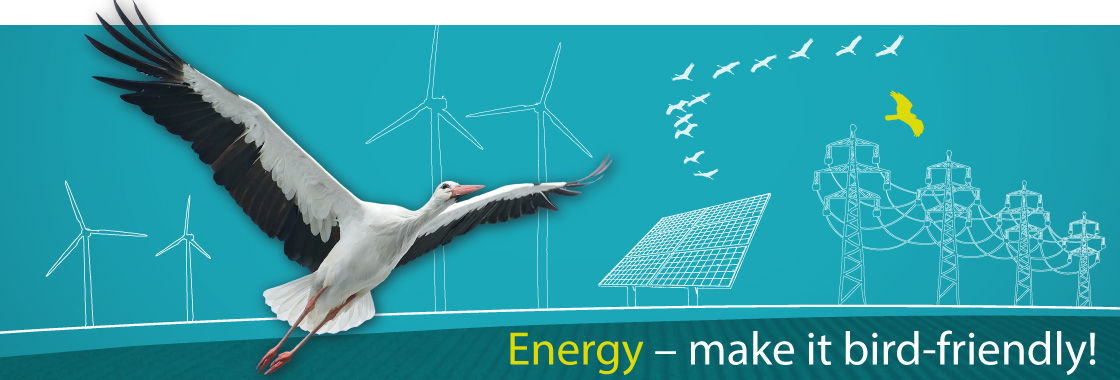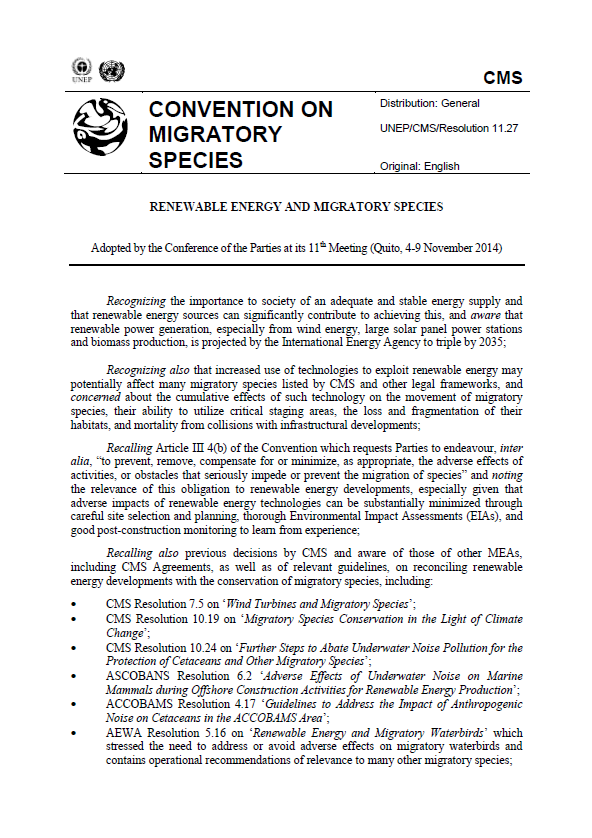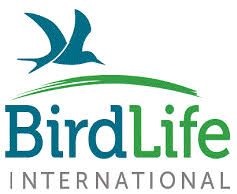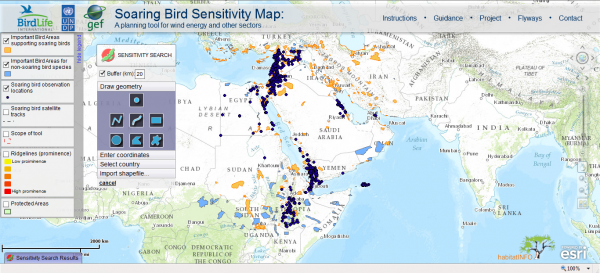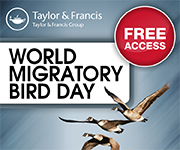You are here
World Migratory Bird Day 2015: Energy - make it bird-friendly!
Briefly
In the tenth edition of WMBD, 219 events were registered globally, and it also marked the 20th anniversary year of AEWA – the Agreement on the Conservation of African-Eurasian Migratory Waterbirds – whose Secretariat together with the Secretariat of the Convention on the Conservation of Migratory Species of Wild Animals (CMS) are the organizational drivers for this unique campaign.
The Official WMBD 2015 Poster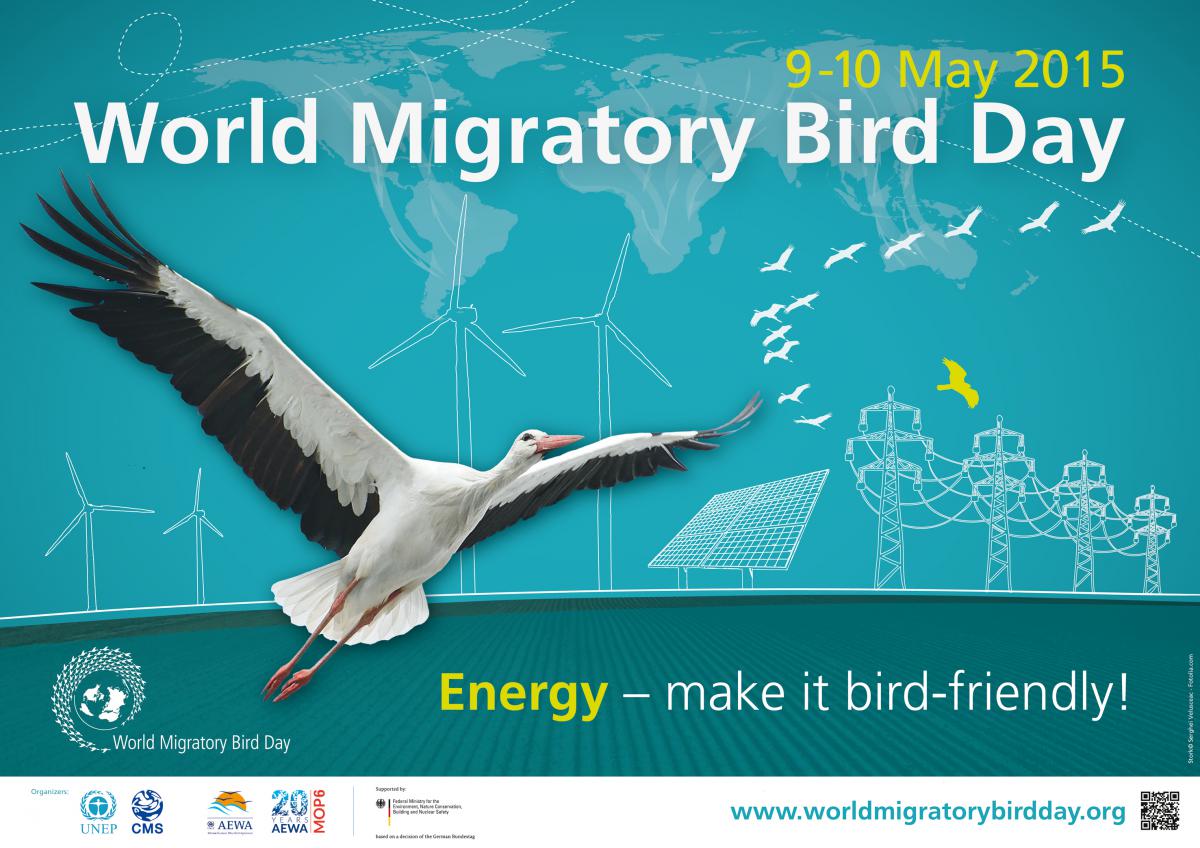
The Theme
In times of ever-increasing global demand for energy, developing new and expanding existing renewable energy technologies are key when striving towards a low carbon future. Yet energy cannot be truly sustainable and nature-friendly unless it fully takes biodiversity and, more specifically, migratory birds into consideration. With the theme “Energy – make it bird-friendly!”, World Migratory Bird Day (WMBD) 2015 aims to highlight the importance of deploying energy technologies in a way that prevents, minimizes and mitigates impacts on migratory birds and their habitats.
Every year, millions of migratory birds struggle with the massive expansion of various means of generating and distributing energy: collisions and electrocution due to power lines as well as barrier effects from energy infrastructure are causing mortality and displacement. In addition, the birds suffer effects from habitat loss and degradation and other disturbances from the deployment of hydropower, bio-energy, ocean, solar, wind and geothermal energy technologies. Sustainable renewable energy production is expected to have positive effects on migratory birds by mitigating climate change and its impacts. However, if certain energy technologies are deployed without proper planning, design and risk assessment, they can pose a grave threat to migratory bird species.
When expanding energy production, transition to wildlife-friendly methods is a key step to protect life on the Earth. The conservation of migratory birds needs to be considered in all phases of energy development at multiple levels - locally, nationally and internationally. Therefore, concerted conservation actions by governments, nature conservation organizations, scientists and the energy sector as well as the general public are necessary. This way the benefits of sustainable energy can be realized without the risk of harming migratory birds and their habitats.
World Migratory Bird Day 2015 also marks the 20th anniversary year of AEWA – the Agreement on the Conservation of African-Eurasian Migratory Waterbirds – whose Secretariat together with the Secretariat of the Convention on the Conservation of Migratory Species of Wild Animals (CMS) are the organizational drivers for this unique campaign.
Check out official statements that marked the tenth World Migratory Bird Day (2015)
More Information on Migratory Birds and Energy:
CMS Resolution on Renewable Energy and Migratory Species [pdf]
In 2014 Parties of the Convention on the Conservation of Migratory Species (CMS) adopted at their eleventh Conference a resolution on renewable energy and migratory species. The Resolution calls for wind, ocean and solar energy as well as hydropower and geo-energy to be planned and developed in a way which avoids or minimizes adverse impacts on migratory species such as displacements, disturbances or mortalities.
Through the resolution, Parties to the Convention on Migratory Species (CMS) endorsed a first set of voluntary Guidelines entitled “Renewable Energy Technologies and Migratory Species – Guidelines for Sustainable Deployment”. The Guidelines will also be presented to Parties of the African-Eurasian Migratory Waterbird Agreement (AEWA) at its 6th Meeting of the Parties (MOP6) scheduled to take place in November 2015.
Executive Summary
Guidelines for Mitigating Conflict Between Migratory Birds and Electricity Power Grids. [pdf]
These guidelines propose actions to mitigate the impacts of electricity infrastructure on migratory birds. They were compiled by Bureau Waardenburg, the Endangered Wildlife Trust, Boere Conservation Consultancy and STRIX Ambiente e Inovação for the Secretariats of the Convention on the Conservation of Migratory Species of Wild Animals (CMS) and the Agreement on the Conservation of African-Eurasian Migratory Waterbirds (AEWA).
Migratory Soaring Birds Project [Link]
The Migratory Soaring Birds project aims to integrate conservation management objectives into targeted public and private sectors in 11 countries along the Rift Valley / Red Sea flyway. It is implemented by BirdLife International with the support of the Global Environment Facility (GEF), and the United Nations Development Programme (UNDP). The linked page provides detailed guidance regarding birds and the energy sector.
Soaring Bird Sensitivity Map Tool [Link]
The Soaring Bird Sensitivity Map Tool has been designed to provide developers, planning authorities and other interested stakeholders access to information on the distribution of soaring bird species along the Rift Valley / Red Sea flyway. This information can help to inform decisions on the safe siting of new developments, such as wind farms, ensuring that negative impacts on this important migration route are minimized.
Free access to research [Link]
To celebrate World Migratory Bird Day 2015, Taylor & Francis is pleased to offer free access to all the latest research related to this year’s theme - “Energy – make it bird-friendly!”.
Simply click here to view the full list of articles, free to access until 31 December 2015.
Connecting Energy, Protecting Nature [pdf]
This briefing paper presents a case for protecting nature in the delivery of the EU’s energy infrastructure projects of common interest. It was produced by BirdLife Europe and the European Environmental Bureau.
Greening Blue Energy: Identifying and managing the biodiversity risks and opportunities of offshore renewable energy. [pdf]
This report synethizes over 1000 reports and documents on the potential biodiversity impacts of offshore wind energy including the potential impact on migratory birds. It was produced by the International Union for Conservation of Nature, E.ON Climate and Renwables and the Swedish International Development Cooperation Agency.
Checkout Press and Media Coverage and Material for WMBD 2015
Archived Download Materials for WMBD 2015 are still available

